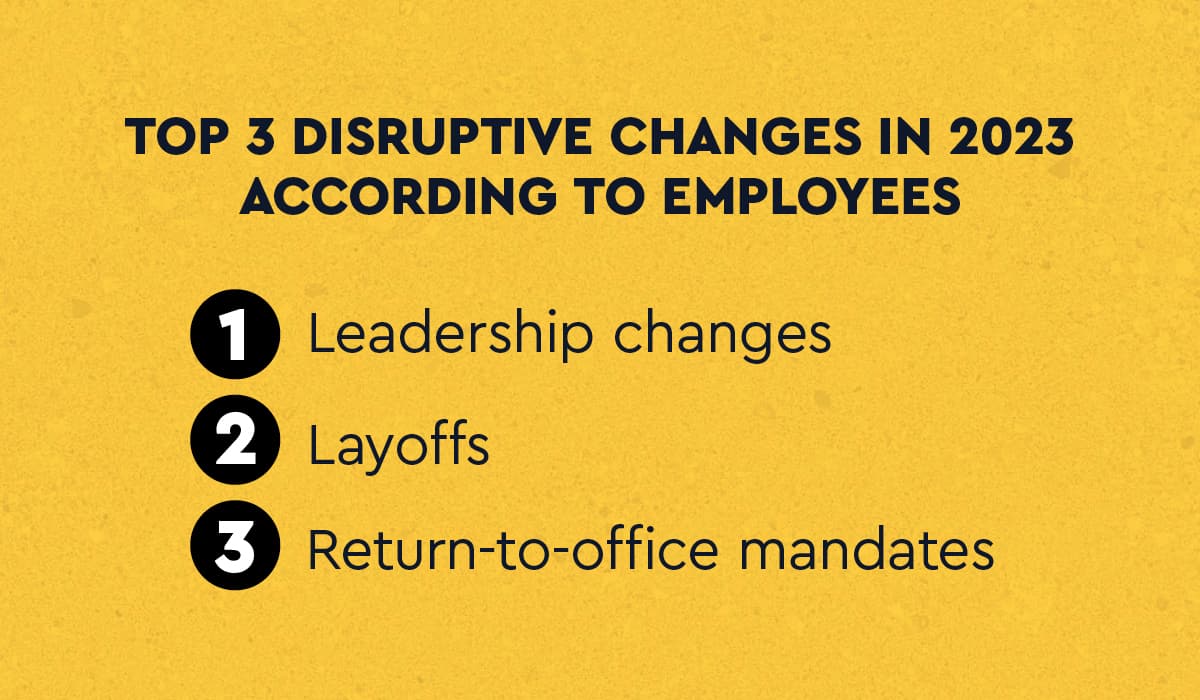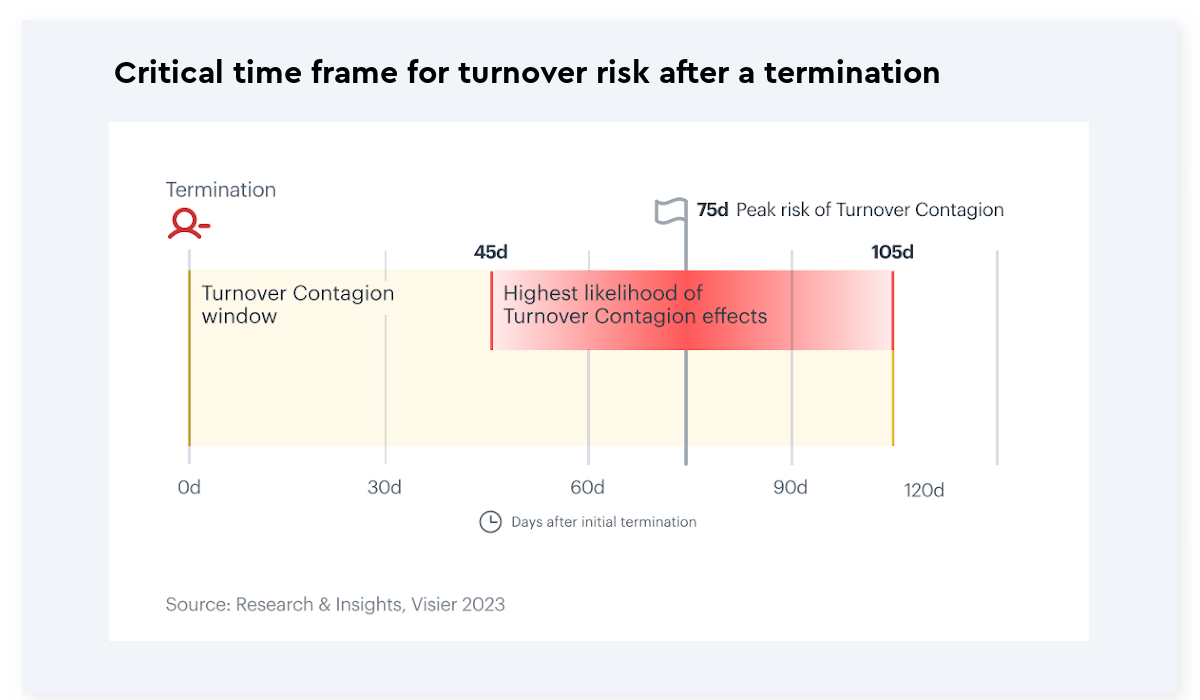A Year of Change Fatigue: New Research Reveals That Employees Are More Anxious and Distrusting After a Turbulent 2023
“Change Fatigue” was trending in 2023. New research shows employees are worn out from frequent shifting of priorities, policies, and personnel. Will 2024 be better?

From the performance of productivity theater to quiet ambition's lack of career aspirations, there's no denying that the past year has been a volatile time in the workplace, with new HR terms popping up left and right. Add in global economic uncertainty and scores of layoffs, and it’s easy to see why a term like “Change Fatigue” was trending in 2023. Employees were worn out from so much shifting of priorities, policies, and personnel.
As a leader in people analytics, Visier wanted to find out how employees reacted to a tumultuous working year. In late 2023, we surveyed 1,000 U.S.-based full-time employees about organizational changes at their companies, their workplace anxieties in the wake of these shifts, and the uncertainties of the past year.
The survey revealed that employees are more anxious and less trusting of their employers in 2023 than they were in 2022—and that the employee experience is now more important than ever to ensure employee satisfaction, motivation, and retention.

Organizational changes are negatively impacting employees
Employees held the upper hand during the Great Resignation, but a looming recession shifted control back to employers—leaving many employees experiencing whiplash. In 2023, or what we’re dubbing the “year of change exhaustion,” employees have endured many uncertainties—both small and large.
When we asked respondents what events they experienced at a company they worked for in 2023, leadership changes or executive turnover, reduction in workforce/layoffs, and return to office topped the list.

While only between a third and a quarter experienced the top three surveyed events, it’s important to remember that the intensity of these types of changes (e.g., a company layoff) is often tremendously disruptive. Shifts like leadership changes or executive turnover have much more potential than individual employee performance to harm the organization and even cause disruption in the market—take Sam Altman and OpenAI, for example.
Turnover contagion: Another risk of workforce upheaval
Organizations can also experience a ripple effect of layoffs in the form of additional, unplanned resignations by remaining employees, a phenomenon called turnover contagion. Recent Visier research showed that employees were 7.7% more likely to quit their jobs after their team member was terminated.

From: Behind the Hype: Data-Backed Insights About Layoffs (Visier, 2023)
On the other hand, more than a third of respondents (35%) did not experience any of the changes we surveyed for.
Companywide changes where respondents worked in 2023
(respondents could choose more than one answer)
Changes at respondents' places of work | % reporting the change |
|---|---|
Leadership changes or executive turnover | 32% |
Reduction in workforce/layoffs | 30% |
Return to office | 24% |
Pay cuts | 16% |
Merger or acquisition | 12% |
TIE: Labor strike & Creation of a union | 9% |
Additionally, while a third of respondents said they experienced no negative impact from company changes in 2023, two-thirds did. Most significantly, changes to flexible work hours, remote and hybrid work policies, and paid time-off policies have been the most widespread.
Organizational changes to company policies and initiatives that negatively impacted employees in 2023
(respondents could choose more than one answer)
Changes made to various types of policies & initiatives | % negatively impacted |
|---|---|
Flexible work hours | 24% |
Remote and hybrid work policy | 22% |
Paid time-off policy | 21% |
Diversity, equity, and inclusion (DEI) programs | 20% |
Mental health and well-being support programs | 17% |
In-person events | 16% |
Non-healthcare benefits (e.g., commuter stipend) | 12% |
Virtual events | 11% |
Learning and development (L&D) programs | 9% |
Unfortunately, most employees don’t see a reprieve from uncertainty in sight—75% of respondents anticipate some sort of policy/initiative change will affect them in 2024. In line with the previous findings, 28% of employees said they think their employer will change flexible work hours, followed by remote and hybrid work policies (25%), and paid time-off policies (23%).

Considering that organizations expect employees to be just as productive (or sometimes even more productive) during periods of economic uncertainty, the level of disruption employees experience can affect their mindsets and morale. This can ultimately lead to decreased productivity.
Employees are also concerned about their compensation. In fact, 81% of respondents agree they are concerned that their company will not offer pay raises that keep up with inflation demands—with 45% strongly agreeing.
With all these changes, we wanted to know if employers were considering employee input when it comes to policy changes. Only 24% of respondents say they were given an opportunity all of the time to voice their concerns/ideas before they were rolled out. Twenty-two percent were given the opportunity some of the time, while 18% said rarely/none of the time—meaning almost half (40%) of respondents don’t have much say at all about policy changes.
Uncertainties lead to increased burnout and anxiety—especially for younger employees
Given the changes organizations experienced in 2023, it should come as no surprise that employees’ feelings are shifting—mostly for the worse. So, what are the side effects of all these changes?
Seven in 10 respondents agree that they are more anxious at work in 2023 than they were in 2022 and, how anxious you are depends on your age. The survey found that the younger an employee is, the more anxious they are.

Eighty-three percent of millennials agree that they are more anxious at work in 2023 than they were in 2022—with over half (55%) strongly agreeing. Seventy-six percent of Gen Z also agree. On the other hand, only 65% of Gen X agree and 55% of baby boomers agree they are more anxious in 2023.
When respondents were asked to indicate the most significant feelings/behaviors affecting their past year of work, they most often mentioned increased burnout (38%), increased stress or anxiety levels (33%), and increased desire to job search (30%). This data is especially alarming for organizations as they attempt to enhance productivity levels and motivate employees to do more with less. Now the question for employers becomes how to grow talent when employees are burned out, less motivated, and experiencing greater job dissatisfaction.
Feelings or behaviors employees most significantly experienced as a result of their work in 2023
Negative feelings experienced by employees in 2023 | % experiencing feeling |
|---|---|
Increased burnout | 38% |
Increased stress or anxiety levels | 33% |
Increased desire to job search | 30% |
Decreased motivation | 23% |
Decreased job satisfaction | 22% |
Loss of connection to coworkers | 21% |
Difficulty in maintaining work-life balance | 17% |
Reduced productivity | 8% |
Employees seek their own changes by job-hunting as employer trust drops
In light of the changes of 2023 and the ensuing negative repercussions, it’s not surprising that employee trust in employers is down year over year. In August 2022, 90% of respondents agreed they trust their employer. But now only 76% of employees agree they trust their employer.
And, perhaps as a result, job seeking is slightly up year over year. In June 2022, during the Great Resignation, 21% of employees said they were actively looking for a new job. Now 27% say they are actively job seeking. Forty-five percent say they are open to a new job, but not actively looking. This slight change is significant because even though economic and hiring conditions are worse, employees are so dissatisfied that they're still moving forward with their job searches.

Who’s on the (job) hunt?
72% of employees say they are either actively looking for a new job or open to one.
Full-time in-office workers are ready for a change: More than half of full-time remote and hybrid employees are open to a new job, but not actively looking. On the other hand, 30% of full-time in-office workers are actively looking for a new job, which is significantly higher than their remote and hybrid counterparts.
Millennials may be on the move: Alarmingly, nearly half of millennials (46%) say they are actively looking for a new job. The majority of Gen Z (50%) and Gen X (54%) say they’re open to a new job, but not actively looking. And nearly half of baby boomers (47%) say they’re not looking to switch jobs, which makes sense given they’re closer to retirement.
Renew focus on the employee experience and address change fatigue

2023 was rife with leadership changes, RIFs, and return-to-office transitions, leaving many employees reeling. These organizational changes can cause concerning side effects like increased anxiety, decreased trust in employers, and increased desire to job search.
While many of these changes are unavoidable, when employees are presented with transparency and an opportunity to voice their preferences, employers stand a better chance of engaging their workforce amid uncertainty. In fact, 81% of respondents said having a greater opportunity to voice their thoughts and perspectives on policy changes would help them feel more engaged at work.
With 72% of employees saying they are either actively looking for a new job or open to one, it’s clear that business leaders still need to focus on the employee experience to keep their employees happy and engaged where they are.



